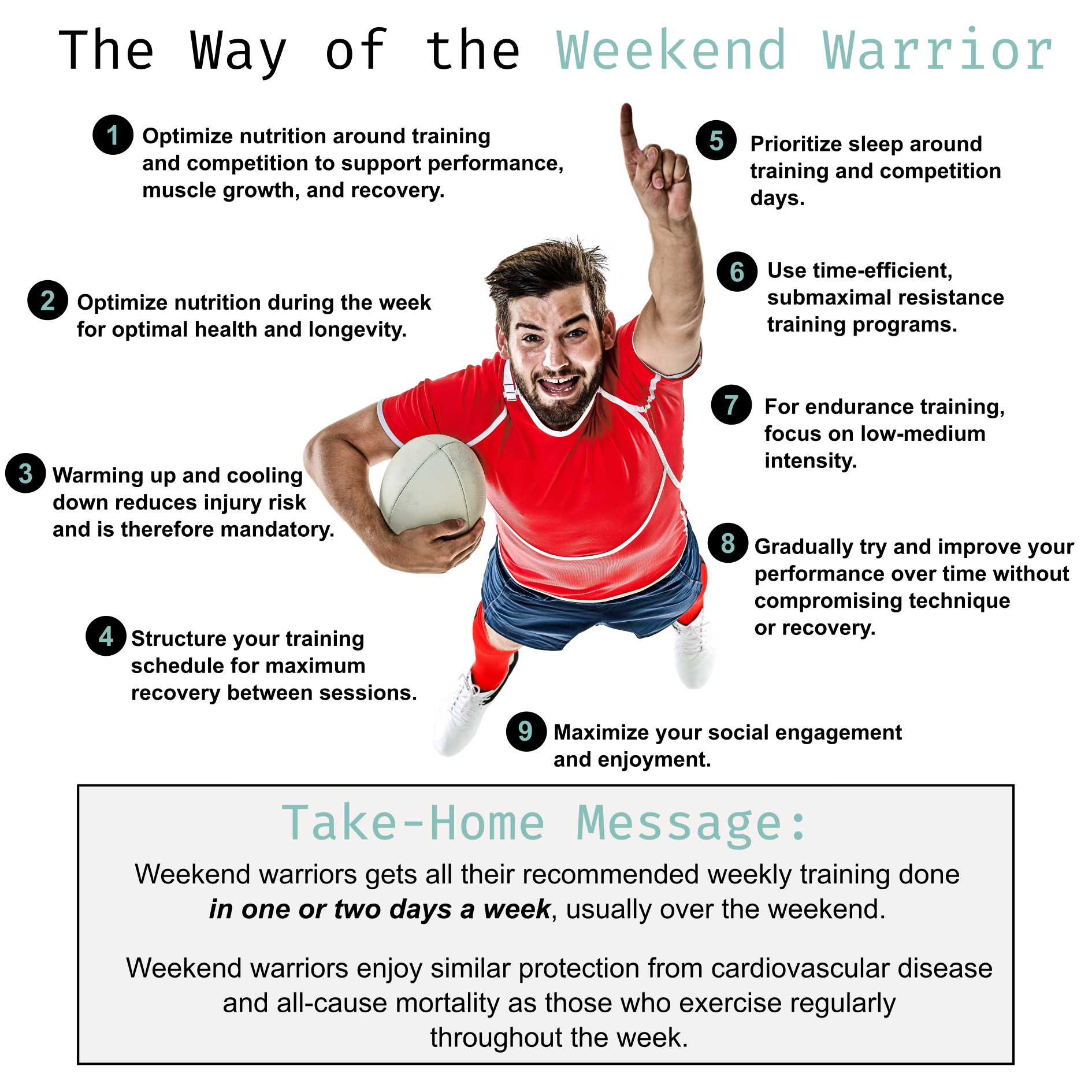The Way of the Weekend Warrior

‘Don’t let the perfect be the enemy of the good!’
Voltaire
1. Executive Summary
In today’s fast-paced world, finding time to adhere to the recommended weekly exercise guidelines can prove challenging. Balancing commitments like work, family, and social activities often relegates physical activity to the sidelines.
However, emerging research offers a ray of hope in the form of the “Weekend Warrior” workout pattern – squeezing an entire week’s worth of exercise into one or two days over the weekend.
While this approach may initially seem too good to be true, numerous studies have demonstrated its efficacy in conferring significant health benefits that are comparable to regular daily exercise.
This article delves into the “Way of the Weekend Warrior”, exploring the scientific evidence, considerations, and strategies for those considering this condensed workout regimen.
2. Introduction
Based on the WHO recommendations for optimal health and longevity (see Box 1), people who enjoy training really hard can scrape by with a mere two-and-a-half hours per week of brutal conditioning and heavy lifting.
Those with a less masochistic inclination have the option of engaging in moderate aerobic exercise for two and a half hours a week, plus two resistance training sessions on top of that.
However, for optimal health it’s recommended that you engage in two-and-a-half hours of vigorous, or five hours of moderate aerobic training, plus 2-3 lifting sessions per week.
Yikes!
Unsurprisingly, it turns out that most people don’t have the time or inclination to train that much. But do you really need to train four-to-six days a week to be healthy?
Perhaps not, according to the latest scientific research.
Box 1. WHO Exercise Recommendations
Adults (aged 18–64 years) including those with chronic conditions and those living with disability
Adults should do at least 150–300 min of moderate-intensity aerobic physical activity, or at least 75–150 min of vigorous-intensity aerobic physical activity, or an equivalent combination of moderate-intensity and vigorous-intensity activity throughout the week for substantial health benefits (11).
Furthermore, adults should also do muscle-strengthening activities at moderate or greater intensity that involve all major muscle groups on 2 or more days a week, as these provide additional health benefits (11).
Strong recommendation
Adults may increase moderate-intensity aerobic physical activity to >300 min, or do >150 min of vigorous-intensity aerobic physical activity, or an equivalent combination of moderate-intensity and vigorous-intensity activity throughout the week for additional health benefits (when not contraindicated for those with chronic conditions) (11).
Older adults (aged 65 years and older) including those with chronic conditions and those living with disability
In older adults, physical activity also helps prevent falls and falls-related injuries and declines in bone health and functional ability (11).
It is recommended that as part of their weekly physical activity, older adults should do varied multicomponent physical activity that emphasizes functional balance and strength training at moderate or greater intensity on 3 or more days a week, to enhance functional capacity and to prevent falls (11) .
3. The Concept of the Weekend Warrior
What is a weekend warrior, you may ask?
Well, in the context of exercise, a weekend warrior is a person who gets all their recommended weekly training done in one or two days a week, usually over the weekend (1).
That’s right, weekend warriors cram seven days of physical activity into a mere two days!
Thus, far from being a disparaging label, the title of weekend warrior as a badge of honor that acknowledges the brutal amount of work performed by these individuals every weekend.
4. The Science Behind the Weekend Warrior Workout
Clues that infrequent bouts of exercise may produce significant health benefits were first revealed in the Harvard Alumni Health Study, a long-term research program that assesses the impact of lifestyle on the health and wellbeing of men who were undergraduates at Harvard University between 1916 and 1950 (1).
From this cohort, researchers classified 8,421 men as:
- “sedentary” (expending <500 kcal/week)
- “insufficiently active” (500–999 kcal/week)
- “weekend warriors” (≥1,000 kcal/week from sports/recreation 1–2 times/week)
- “regularly active” (all others expending ≥1,000 kcal/week)
Note that the weekend warriors expended the same total energy from sport and recreation as the regularly active people, however they did so within one or two days!
The remarkable finding from the Harvard Alumni Health Study was that ‘among men without major risk factors, weekend warriors had a lower risk of dying, compared with sedentary men’ (1).
Thus, jamming all your recommended exercise into one or two sessions per week may help you live longer.
5. Comparing Weekend Warriors to Regular Exercisers
Skeptical?
Perhaps, like me, you assume that exercising once or twice a week just isn’t enough?
If so, it’s a good thing that Dr Kunutsor and Colleagues pooled the data from four separate studies (1-4) to better assess whether the weekend warriors really are protected against premature death (5).
And indeed, they are!
After analyzing the combined data consisting of 426,428 people, the Author’s found that weekend warriors enjoy a 27% reduced risk of death from cardiovascular disease and a 17% reduced risk of death from all causes when compared to inactive people (5)!
Strikingly, the combined data revealed that weekend warriors enjoy similar protection from cardiovascular disease and all-cause mortality as those who exercise regularly throughout the week (5)!
Thus, the most up to date research indicates that training once or twice a week is sufficient to protect you from an early grave.
Weekend warriors rejoice!
6. Drawbacks and Potential Risks of Being a Weekend Warrior
Before you jump on the weekend warrior bandwagon, note that there are several important caveats to consider.
1. There are no Randomized Clinical Trials
All the research to date regarding weekend warriors consists entirely of observational studies.
Observational studies collect data from a large group of people, and then correlate different variables with an outcome of interest. In the case of the weekend warrior, the variables were exercise volume and frequency (i.e., a high volume, low frequency weekend warrior approach), which was compared with mortality.
Because there aren’t any direct interventions in the form of clinical trials, all we currently have is a statistically significant correlation between being a weekend warrior and not dying. Sadly, we can’t be sure of causation.
But, I hear you ask, isn’t there already an established link between exercise and not dying? Can’t we simply extrapolate from what we know about exercise to the specific example of the weekend warrior?
Probably.
However, we can’t exclude other variables. For example, who are these weekend warriors?
My guess is that many weekend warriors are motivated individuals with a background in competitive sport (i.e., former amateur athletes), who kept training and competing on weekends despite career and family commitments.
If this is true, the maintenance of a previously established fitness base could help explain why weekend warriors enjoy such good health compared to their inactive peers.
However, it’s well established that training volume matters (6), therefore the high volume of exercise performed by weekend warriors is highly likely to induce protective physiological adaptations, and thus better health.
Moreover, the discovery that exercise bouts of less than ten minutes have a surprisingly positive effect on health and mortality (7), lends further support to the notion that the herculean exercise volume warriors crank out over the weekend is highly likely to improve physical fitness.
2. Social Network
In addition, many weekend warriors participate in social sporting events, and are therefore likely enjoy a robust and vibrant social life, which we know is protective against premature death (8).
Right now, we can’t exclude the social network hypotheses, as we simply don’t have the data.
But who cares? If participating in social sport on the weekend increases your social capital and thereby extends your life, that’s great!
3. Risk of Injury
Performing a high volume of exercise within a short amount of time induces fatigue, and fatigue increases your chance of getting injured.
Do weekend warriors experience more injuries than people who train regularly?
The evidence suggests that yes, indeed they do. In fact, weekend warriors suffer a higher rate of severe injuries than those who exercise on weekdays (9, 10).
Bummer.
But don’t despair. As you’ll see below, you can minimize injury risk through fatigue management.
4. Diet Really Matters for the Weekend Warrior
They say you can’t out-train a bad diet. This is especially true for the weekend warrior.
Granted, you certainly burn fat during and after exercise. However, the weekend warrior’s fat-burning window is tightly compressed to within two days, which leaves the remaining five days of the week wide open for fat accumulation.
The constrained fat-burning window also makes fat loss more challenging for the weekend warrior compared to the regular exerciser.
Furthermore, you rely on muscle glycogen stores to provide the energy to perform at high intensities, and muscle glycogen takes about twenty-four hours to replenish. Thus, if the weekend warrior burns through their precious glycogen reserves on Saturday, it’s a significant challenge for them to restore their glycogen levels to compete or train hard on Sunday.
The limited fat-burning window combined with glycogen depletion mean that the weekend warrior’s diet must be on point if they want to improve their metabolic health, maintain their body composition, and deliver optimal performance during a grueling weekend of competition and training.
5. Control Your Intensity for Maximum Return-On-Investment
Training intensity is a crucial consideration for any athlete, but for the weekend warrior it’s essential to train at the right intensity for three reasons.
The first and most important reason is injury avoidance. As discussed above, weekend warriors are prone to injury, notably serious injury (10).
Competing or training while fatigued greatly increases your chance of injury, making fatigue management crucially important if you want to avoid getting hurt.
Second, weekend warriors compress their entire weekly exercise volume into one or two days. Obviously, this is incredibly tiring. Therefore, weekend warriors must carefully regulate their training intensity if they want to make it through their heroic workload.
Finally, research suggests that there is an optimal training intensity for the weekend warriors that maximizes health (4). And guess what, it’s not training at an insanely high intensity like a masochistic fool!
Rather, the evidence suggests that weekend warriors experience the greatest return on investment if they stick primarily to moderate training intensities (4).
7. Tips and Strategies for Becoming a Successful Weekend Warrior
For the weekend warrior, training volume is the coin of the realm.
The overall aim of the weekend warrior is to compress a weeks’ worth of training volume into two days (i) without getting injured; (ii) while maintaining optimal performance throughout your workouts and competition; and (iii) while implementing some form of progressive overload to drive physiological adaptation.
Box 2 outlines the core principles to consider if you are contemplating becoming a weekend warrior.
Box 2. Core Principles for Weekend Warrior Training
- Optimizing nutrition around training and competition to support muscle growth, replenish glycogen stores, and support recovery and adaptation. In other words, when training and competing, eat a nutrient-dense diet that has a surplus of calories. Further, meal timing is crucial: you must use your one hour feeding window after training to fully replenish your bodies energy stores and provide optimal nutrition for muscle growth. Finally, supplementing throughout your training and competition with energy drinks and energy bars while maintaining hydration is essential for maintaining your performance.
- Optimize nutrition during the week for health and longevity. That means consuming nutrient-dense food while being in a calorie-neutral or slight calorie deficit for maintaining optimal body composition and health. Consider fasting, but not around or during training/competition days.
- Warming up and cooling down reduces injury risk and is therefore mandatory.
- Structure your training schedule to allow for maximum recovery between sessions. If possible, split your workouts into morning and evening sessions.
- Prioritize sleep around training and competition days.
- For resistance training, use submaximal training programs that are designed with training efficiency in mind. DO NOT OVERTRAIN! Exercise selection should be focused on compound movements (squat, deadlift, cleans, bench press, shoulder press, rows, and pull-ups). Developing solid exercise technique for each lift is crucial to avoid injury.
- For endurance/conditioning, train at medium intensity, preferably utilizing a low-impact form of exercise that allows you to train for extended periods of time without beating up your joints (e.g., cycling, rowing).
- Record key workout variables such as distance, times, weight lifted, and repetitions. Gradually try and improve your performance in these metrics over time without compromising technique or recovery.
- Maximize your social engagement and enjoyment.
8. Conclusions and Future Directions
Make no mistake, you will never reach your full athletic potential as a weekend warrior (6).
But, as a great man once said, ‘Don’t let the perfect be the enemy of the good!’.
After all, we don’t live in a perfect world, and not everyone wants to be a super-athlete.
However, everyone deserves to be healthy.
The way of the weekend warrior is one path to health that also leaves plenty of room in your life for the pursuit of other activities that you find important and meaningful.

9. References and Further Reading
1. I.-M. Lee, H. D. Sesso, Y. Oguma, R. S. Paffenbarger Jr, The “weekend warrior” and risk of mortality. American Journal of Epidemiology 160, 636-641 (2004).
2. G. O’Donovan, I.-M. Lee, M. Hamer, E. Stamatakis, Association of “weekend warrior” and other leisure time physical activity patterns with risks for all-cause, cardiovascular disease, and cancer mortality. JAMA Internal Medicine 177, 335-342 (2017).
3. E. J. Shiroma, I.-M. Lee, M. A. Schepps, M. Kamada, T. B. Harris, Physical activity patterns and mortality: the weekend warrior and activity bouts. Medicine and Science in Sports and Exercise 51, 35 (2019).
4. M. Dos Santos et al., Association of the “weekend warrior” and other leisure-time physical activity patterns with all-cause and cause-specific mortality: A nationwide cohort study. JAMA Internal Medicine 182, 840-848 (2022).
5. S. K. Kunutsor, S. Y. Jae, J. A. Laukkanen, ‘Weekend warrior’and regularly active physical activity patterns confer similar cardiovascular and mortality benefits: a systematic meta-analysis. European Journal of Preventive Cardiology 30, e7-e10 (2023).
6. T. O. Bompa, C. Buzzichelli, Periodization-: Theory and Methodology of Training. (Human kinetics, 2019).
7. J. M. Jakicic et al., Association between bout duration of physical activity and health: systematic review. Medicine and Science in Sports and Exercise 51, 1213 (2019).
8. N. Schutter et al., Loneliness, social network size and mortality in older adults: a meta-analysis. Eur J Ageing 19, 1057-1076 (2022).
9. J. Kruger, S. A. Ham, H. W. Kohl 3rd, Characteristics of a” weekend warrior”: results from two national surveys. Medicine and Science in Sports and Exercise 39, 796-800 (2007).
10. D. J. Roberts et al., The “weekend warrior”: Fact or fiction for major trauma? Canadian Journal of Surgery 57, E62 (2014).
11. F. C. Bull et al., World Health Organization 2020 guidelines on physical activity and sedentary behaviour. British Journal of Sports Medicine 54, 1451-1462 (2020).

Ten Minutes is All You Need
Research has shown that ten minutes of moderate-to-vigorous exercise performed each day is enough to significantly reduce your risk of early death.
- « Previous
- 1
- …
- 31
- 32
- 33



